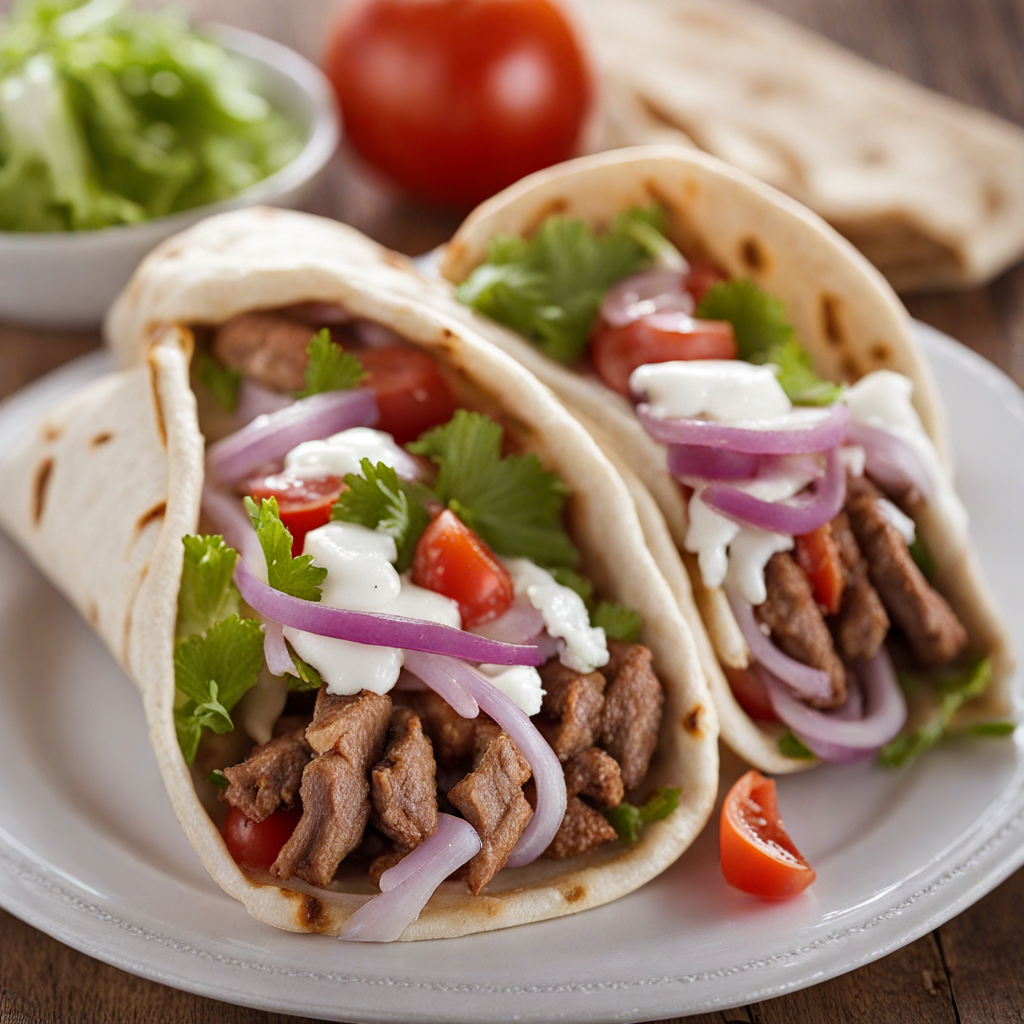Spanakopita
Spanakopita is a delightful Greek pastry that showcases the vibrant flavors of fresh spinach combined with creamy feta cheese, all enveloped in layers of crispy phyllo dough. This dish is not only a feast for the palate but also a visual treat, as its golden-brown exterior contrasts beautifully with the lush green filling. Each bite delivers a satisfying crunch followed by the rich, savory taste of the spinach and cheese, making it an irresistible appetizer or snack that captures the essence of Mediterranean culinary traditions. The preparation of Spanakopita involves a careful balance of textures and flavors. The phyllo dough, known for its paper-thin layers, is brushed with olive oil or melted butter to create a flaky crust that perfectly encases the filling. The combination of herbs such as dill and parsley with the spinach adds a refreshing brightness, while the feta contributes a tangy creaminess that elevates the dish. Often enjoyed warm or at room temperature, Spanakopita can be served as part of a meze platter or as a standalone treat, perfect for gatherings or casual snacking. This classic Greek dish not only highlights the use of local ingredients but also reflects the country’s rich culinary heritage. Spanakopita is often made in large trays and cut into smaller squares or triangles, making it easy to share and enjoy. Whether you are trying it for the first time or revisiting it, Spanakopita promises a unique taste experience that embodies the warmth and hospitality of Greek culture, inviting you to savor the flavors of the Mediterranean.
How It Became This Dish
The History of Σπανακόπιτα: A Journey Through Time and Taste #### Origins Σπανακόπιτα, or spinach pie, is a beloved dish in Greek cuisine that embodies the rich tapestry of flavors, traditions, and agricultural practices in Greece. The word "πίτα" (pita) refers to any type of pie, while "σπανάκι" (spanaki) translates to spinach. This savory pastry is primarily made with spinach, feta cheese, onions, and herbs, all enveloped in layers of flaky phyllo dough. The origins of Σπανακόπιτα can be traced back to ancient Greece, where greens were highly regarded for their nutritional value. Ancient Greeks cultivated a variety of leafy greens, including wild spinach and other foraged greens. The use of greens in cooking was documented by significant philosophers and writers, such as Homer and Aristotle, who noted their health benefits. Early mentions of pies filled with greens can be found in ancient texts, suggesting that the concept of encasing vegetables in dough was not entirely foreign to the Greeks. Phyllo dough itself has roots in the Byzantine Empire, where it was developed and refined. The technique of creating thin layers of dough is believed to have been influenced by Middle Eastern culinary practices, particularly from the Ottoman Empire. The introduction of phyllo transformed the way Greeks prepared pies, allowing for a variety of fillings, including the now-iconic combination of spinach and feta. #### Cultural Significance Σπανακόπιτα is more than just a dish; it is a symbol of Greek culture and tradition. It embodies the agricultural bounty of the Greek landscape, particularly the rich soils of the Peloponnese and the islands, where spinach and other greens thrive. In rural areas, the preparation of Σπανακόπιτα often coincides with the seasonal harvest of spinach, making it a dish that celebrates the rhythms of nature. In Greek households, Σπανακόπιτα is a staple at family gatherings and festive occasions. It often appears on the table during Lent, a period when many Greek Orthodox Christians abstain from meat and dairy. The dish aligns perfectly with the dietary restrictions of the season, providing a nutritious and hearty meal. Its presence during religious holidays, such as Easter, further underscores its cultural significance, as families come together to share traditional foods that have been passed down through generations. Moreover, Σπανακόπιτα has an association with hospitality and community. In many villages, it is common to see neighbors exchanging homemade pies as tokens of goodwill. The act of sharing food strengthens social bonds and reflects the Greek philosophy of "philoxenia," which emphasizes kindness to strangers and the importance of sharing resources. #### Development Over Time As Greek cuisine evolved, so too did the preparation of Σπανακόπιτα. Originally, the filling might have included a variety of greens, such as chard, wild herbs, and even stinging nettles, reflecting the local flora and foraging traditions. Over time, spinach became the predominant choice, particularly with the introduction of feta cheese, which added a creamy, tangy contrast to the dish. In the late 19th and early 20th centuries, as Greece underwent significant socio-political changes, the culinary landscape began to shift. Urban migration and the rise of industrialization brought about new influences and the standardization of recipes. While traditional methods of making Σπανακόπιτα persisted, urban cooks adapted the dish to suit their lifestyles. Pre-made phyllo dough began to emerge in bakeries, making the preparation less labor-intensive and more accessible to the average household. The 20th century also saw the globalization of culinary practices, with Greek immigrants introducing Σπανακόπιτα to international audiences. In cities like New York, Melbourne, and Toronto, Greek communities established restaurants that showcased their rich culinary heritage. This exposure helped to popularize Σπανακόπιτα beyond Greek borders, allowing it to be enjoyed by diverse cultures. As a result, variations began to emerge, with ingredients like ricotta or different herbs making their way into the filling, reflecting local tastes and preferences. Today, Σπανακόπιτα is a common sight not only in Greece but also in Greek restaurants worldwide. It is often served as a meze, a small dish to accompany drinks, or as a main course. The versatility of the dish allows for experimentation, with chefs adding their unique twists, such as incorporating various cheeses, spices, or even additional vegetables. #### Contemporary Relevance In contemporary Greece, Σπανακόπιτα continues to hold a cherished place in national cuisine, often enjoyed by families and served in tavernas. It is celebrated at culinary festivals, where local farmers and chefs come together to honor traditional recipes and promote sustainable agriculture. The dish has also found a place in the hearts of health-conscious consumers due to its nutritious ingredients, making it a popular choice in vegetarian and vegan diets. Moreover, the emphasis on the Mediterranean diet, recognized for its health benefits, has brought renewed interest to dishes like Σπανακόπιτα. With its rich blend of vegetables, herbs, and healthy fats, the pie is seen as a wholesome option that aligns with modern eating trends. In conclusion, Σπανακόπιτα is a culinary gem that encapsulates the essence of Greek culture and history. From its ancient roots to its modern interpretations, the dish reflects the agricultural practices, social customs, and evolving tastes of the Greek people. As it continues to be celebrated and adapted, Σπανακόπιτα serves as a delicious reminder of the importance of tradition, community, and the enduring power of food to bring people together. Whether enjoyed at a family gathering, a festive celebration, or a cozy meal at home, Σπανακόπιτα remains a timeless symbol of Greek heritage and a testament to the enduring legacy of its flavors.
You may like
Discover local flavors from Greece







